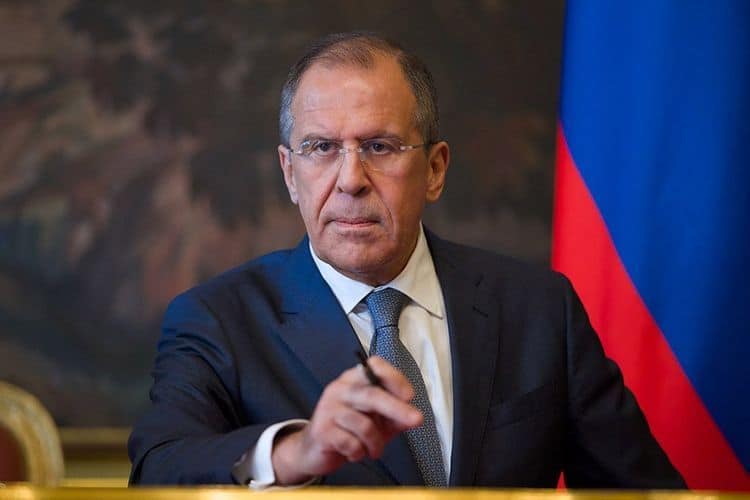Russia to react to massive U.S. military move on its borders

Moscow’s top diplomat has warned his government would take responsive measures to an upcoming, massive U.S. military deployment and U.S.-led exercises across multiple European states bordering Russia. Russian Foreign Minister Sergey Lavrov told official government newspaper Rossiyskaya Gazeta in an interview Monday that “naturally, we will react” to the NATO Western military alliance’s Defender-Europe 20 exercise, which is due next month to begin facilitating the largest U.S. military deployment to Europe in 25 years. The majority of the drills are set to take place in May and June, involving some 36,000 personnel—including 25,000 from the U.S.—across Germany, Poland and the Baltic states of Estonia, Latvia and Lithuania.
“We cannot ignore these processes, which are of great concern, but we will respond in such a way that does not create unnecessary risks,” Lavrov added. “It’s unavoidable. I hope that any normal military official and politician understands this. Those who provoke this kind of absolutely unjustified doctrine want a response in order to continue to escalate tensions. But it’s worth noting that everything that we do in response to the threats created by NATO members to our security we do exclusively on our own territory. Just like all our nuclear weapons are on our territory, unlike American nuclear weapons.”
Newsweek reports in its article RUSSIA SAYS IT ‘WILL REACT’ TO MASSIVE U.S. MILITARY MOVE ON ITS BORDERS, ‘IT’S UNAVOIDABLE’ that U.S. Army Europe describes Defender-Europe 20 as “the deployment of a division-size combat-credible force from the United States to Europe, the drawing of equipment and the movement of personnel and equipment across the theater to various training areas.” The large-scale movement is “linked” to six major U.S.-led exercises: Allied Spirit XI, Dynamic Front 20, Joint Warfighting Assessment 20, Saber Strike 20, Swift Response 20 and Trojan Footprint.
NATO Secretary-General Jens Stoltenberg insisted Monday that “Defender Europe is not directed against any particular country,” according to an article by Agence France-Presse and Japan’s Jiji Press featured in The Japan Times and shared by NATO spokesperson Oana Lungescu. “Russia has every right to feel secure within its borders, but so do our member states.”
In a statement sent to Newsweek, Lungescu said that “Defender-Europe 20 is a US-led exercise, which will comply with all relevant international commitments,” including the Organization for Security and Co-operation in Europe’s Vienna Document that deals with military activities. She said the U.S. has briefed OSCE members on the exercise, including Russia.
“All countries have the right to hold military exercises, as long as they are conducted in line with international commitments. As the name makes clear, Defender-Europe 20 is a defensive exercise. It is not directed against any country,” she continued. “It is about training in peacetime so that we can make sure that our forces can work seamlessly together in a crisis, anywhere in the Alliance. Everything that NATO does is about preventing conflict, not provoking conflict.”
“NATO is a defensive alliance. We do not seek confrontation with Russia,” she added. “It is Russia’s aggressive actions that have reduced stability and security and increased unpredictability in the Euro-Atlantic area. While NATO Allies are transparent in their exercises, Russia has never opened an exercise for mandatory OSCE Vienna Document observation.”
NATO was formed in 1949 as a collective security pact to defend against the Soviet Union and has since grown into a 29-member alliance that has expanded eastward to Russia’s borders. Moscow formed its own Cold War-era treaty, the Warsaw Pact, in 1955, but the agreement fell apart along with the Soviet Union in 1991 and every sovereign member other than Russia has since joined NATO.
Other nations such as Estonia, Latvia and Lithuania that gained independence from the Soviet Union have also joined the U.S.-led coalition, expressing concern that Russia was again attempting to assert its influence across the borders of Eastern Europe. Moscow, however, has argued that it was NATO destabilizing regional security by allowing the Pentagon to deploy advanced missile defense systems since Washington left the Anti-Ballistic Missile (ABM) Treaty in 2002.
Both NATO and Russia have bolstered their flanks in response to growing tensions surrounding Ukraine in 2014, when Russian annexed the Crimean Peninsula in a disputed referendum and was accused by the U.S. and its allies of funding an eastern cross-border insurgency there. On Tuesday, four Russian Su-30SM and two Su-24M fighter jets attached to the Black Sea Fleet “carried out training bombing attacks on the location of the conditional enemy” in at the Opuk training ground in Crimea’s Mount Konchekskaya.
The U.S. also left the 1987 Intermediate-range Nuclear Forces (INF) Treaty last year after accusing Russia of developing a banned mid-range missile. The move has paved the way for both countries to deploy mid-range missiles not seen in Europe for decades.
With another critical non-proliferation agreement, the New Strategic Nuclear Arms Reduction Treaty (START), on the line, Moscow has sought to immediately open talks to renew the agreement before it expires one year from Wednesday, something that would remove all limits and mutual monitoring measures for the world’s two largest nuclear stockpiles. President Donald Trump’s administration has instead sought a new, wider-ranging agreement involving more countries and new weapons platforms as both Washington and Moscow seek to modernize their arsenals.
Russia is developing and has begun to deploy a number of high-tech and hypersonic weapons billed as invincible to the U.S., which has scrambled to establish its own such capabilities. The Pentagon has also charged Moscow with conducting low-yield nuclear warhead tests.
Confirming earlier reporting by Newsweek and the Federation of American Scientists, U.S. Under Secretary of Defense John Rood announced Tuesday that the U.S. Navy “has fielded the W76-2 low-yield submarine-launched ballistic missile (SLBM) warhead” as part of a strategy to counter moves by “potential adversaries, like Russia.”
Source: Vestnik Kavkaza





